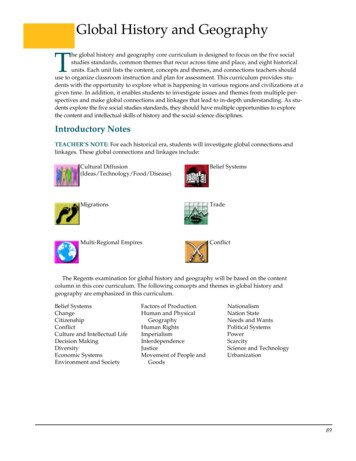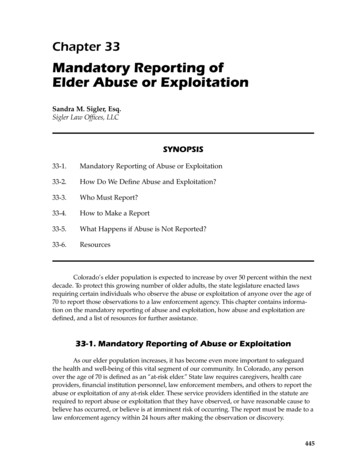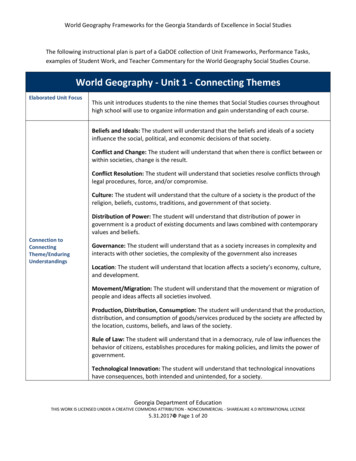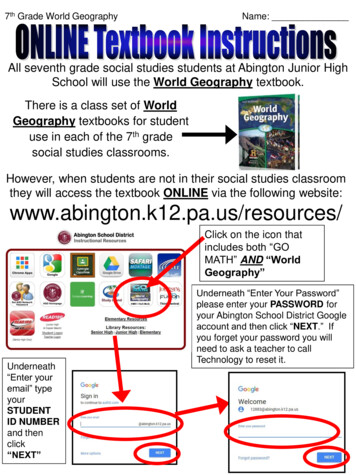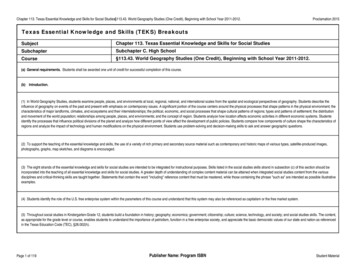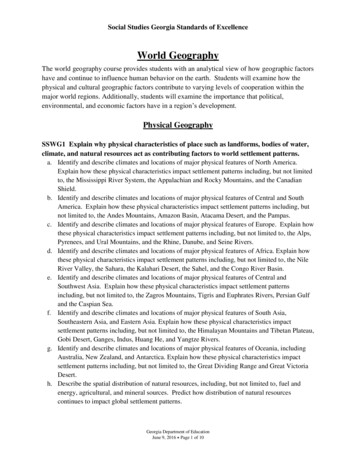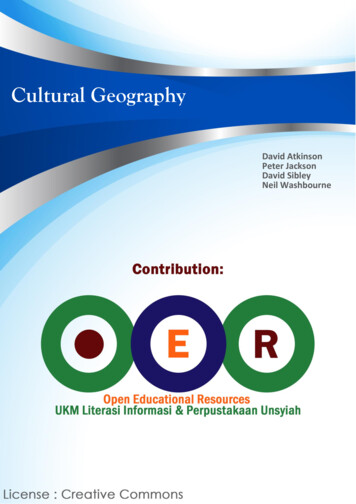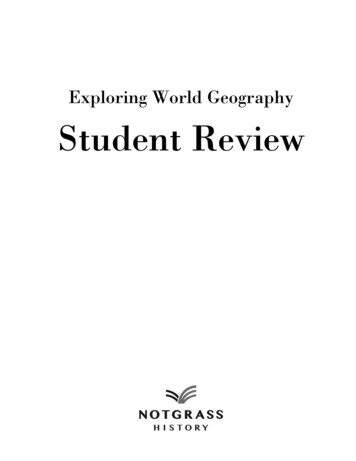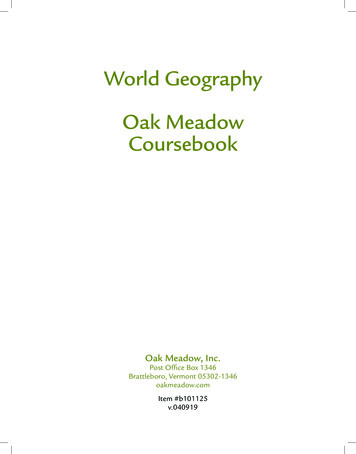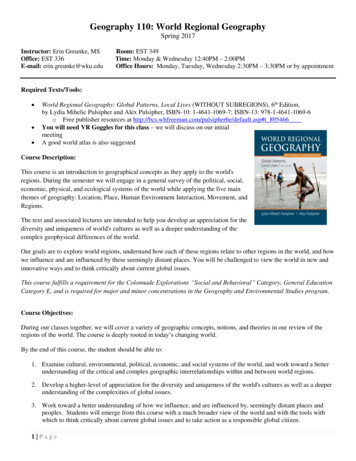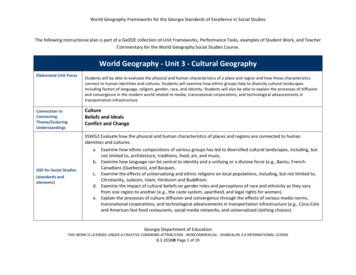
Transcription
World Geography Frameworks for the Georgia Standards of Excellence in Social StudiesThe following instructional plan is part of a GaDOE collection of Unit Frameworks, Performance Tasks, examples of Student Work, and TeacherCommentary for the World Geography Social Studies Course.World Geography - Unit 3 - Cultural GeographyElaborated Unit FocusConnection toConnectingTheme/EnduringUnderstandingsGSE for Social Studies(standards andelements)Students will be able to evaluate the physical and human characteristics of a place and region and how those characteristicsconnect to human identities and cultures. Students will examine how ethnic groups help to diversity cultural landscapesincluding factors of language, religion, gender, race, and identity. Students will also be able to explain the processes of diffusionand convergence in the modern world related to media, transnational corporations, and technological advancements intransportation infrastructure.CultureBeliefs and IdealsConflict and ChangeSSWG2 Evaluate how the physical and human characteristics of places and regions are connected to humanidentities and cultures.a. Examine how ethnic compositions of various groups has led to diversified cultural landscapes, including, butnot limited to, architecture, traditions, food, art, and music.b. Examine how language can be central to identity and a unifying or a divisive force (e.g., Bantu, FrenchCanadians (Quebecois), and Basques.c. Examine the effects of universalizing and ethnic religions on local populations, including, but not limited to,Christianity, Judaism, Islam, Hinduism and Buddhism.d. Examine the impact of cultural beliefs on gender roles and perceptions of race and ethnicity as they varyfrom one region to another (e.g., the caste system, apartheid, and legal rights for women).e. Explain the processes of culture diffusion and convergence through the effects of various media norms,transnational corporations, and technological advancements in transportation infrastructure (e.g., Coca-Colaand American fast food restaurants, social media networks, and universalized clothing choices).Georgia Department of EducationTHIS WORK IS LICENSED UNDER A CREATIVE COMMONS ATTRIBUTION - NONCOMMERCIAL - SHAREALIKE 4.0 INTERNATIONAL LICENSE8.3.2018 Page 1 of 19
World Geography Frameworks for the Georgia Standards of Excellence in Social StudiesConnection to LiteracyStandards for SocialStudies (readingand/or writing)Connection to SocialStudies Matrices(informationprocessing and/or mapand globe skills)L11-12 WHST: 8L11-12RHSS: 1, 2, 6, 7L9-10RHSS: 1, 5, 6Map and Globe Skills: 4-12Information Processing Skills: 1,3,6,8,11,12,15Georgia Department of EducationTHIS WORK IS LICENSED UNDER A CREATIVE COMMONS ATTRIBUTION - NONCOMMERCIAL - SHAREALIKE 4.0 INTERNATIONAL LICENSE8.3.2018 Page 2 of 19
World Geography Frameworks for the Georgia Standards of Excellence in Social StudiesEssential Questions and Related Supporting/Guiding QuestionsEnduringUnderstanding:1. How does language impact a place?CultureEnduringUnderstanding:Beliefs & IdealsEnduringUnderstanding 3How does the physical and human characteristics of places and regions connect to human identitiesand cultures?2. How does religion influence different characteristics of a society?1. What is the impact of cultural beliefs on gender, race and ethnicity?2. How does culture diffuse and converge throughout the world?1.Georgia Department of EducationTHIS WORK IS LICENSED UNDER A CREATIVE COMMONS ATTRIBUTION - NONCOMMERCIAL - SHAREALIKE 4.0 INTERNATIONAL LICENSE8.3.2018 Page 3 of 19
World Geography Frameworks for the Georgia Standards of Excellence in Social StudiesSample Instructional Activities/AssessmentsCultural landscapesStudents will examine two case studies that will show how ethnic compositions of various groups has led to a diversified cultural landscape.1.Chinatown, New York City, USA--Students will use online resources of http://new-york-chinatown.info or http://www.explorechinatown.com toexplore the cultural landscape of Chinatown in New York, New York. They should focus on architecture, traditions, food, art, and music. Using thefollowing handout, students should take down notes on each of the specifics that they see from Chinatown.2. Chicago, Illinois, USA--Students will examine the various ethnic neighborhoods in Chicago and their impact on life and the people there. Use thefollowing websites in your search and understanding of Chicago. Students will research the Chicago ethnic neighborhoods and describe the impactof the culture on the landscape of the city including but not limited to architecture, traditions, food, art, and music. See handout below as anexample. s/2009-11-10-chicago-ethnic-neighborhoods er students complete the two case studies, have them respond in a well written essay on how ethnic compositions of various groups has led toa diversified cultural landscape. Students should include specific examples of architecture, traditions, food, art, and music that contributed to theculture landscape of the city.GSE Standards andElementsLiteracy StandardsSocial Studies MatricesEnduringUnderstanding(s)a. Examine how ethnic compositions of various groups has led to diversified cultural landscapes,including, but not limited to, architecture, traditions, food, art, and music.L11-12 WHST: 8L11-12RHSS: 1, 2, 6, 7L9-10RHSS: 1, 5, 6Map and Globe Skills: 4-12Information Processing Skills: 1,3,6,8,11,12,15How does the physical and human characteristics of places and regions connect to human identitiesand cultures?Georgia Department of EducationTHIS WORK IS LICENSED UNDER A CREATIVE COMMONS ATTRIBUTION - NONCOMMERCIAL - SHAREALIKE 4.0 INTERNATIONAL LICENSE8.3.2018 Page 4 of 19
World Geography Frameworks for the Georgia Standards of Excellence in Social StudiesStudent ActivityChinatown, New York City, USAUsing the following online resources of http://new-york-chinatown.info or http://www.explorechinatown.com, explore the culturallandscape of Chinatown in New York, New York. Focus on the cultural impact on the architecture, traditions, food, art, and music.1. How is the architecture in Chinatown different from other parts of New York City?2. What type of festivals or traditions does Chinatown seem to have?3. What types of food do the people serve and have available?4. Does the art display characteristics of China?5. How do the signs display Chinese culture and American culture?6. What other features of Chinatown show the impact of the Chinese people and culture on the landscape of New York city?Georgia Department of EducationTHIS WORK IS LICENSED UNDER A CREATIVE COMMONS ATTRIBUTION - NONCOMMERCIAL - SHAREALIKE 4.0 INTERNATIONAL LICENSE8.3.2018 Page 5 of 19
World Geography Frameworks for the Georgia Standards of Excellence in Social StudiesStudent Activity 2: Cultural Landscapes of ChicagoGo to the following articles websites and read about each ethnic oods tions: Describe the cultural characteristics of each neighborhood in Chicago mentioned in the articles.ChinatownGreektownLittle ItalyMexicanPolishSouth AsianGeorgia Department of EducationTHIS WORK IS LICENSED UNDER A CREATIVE COMMONS ATTRIBUTION - NONCOMMERCIAL - SHAREALIKE 4.0 INTERNATIONAL LICENSE8.3.2018 Page 6 of 19
World Geography Frameworks for the Georgia Standards of Excellence in Social StudiesLanguageStudent assignment:As a whole class watch (in whole or clips) the TED talk “How language shapes the way we think”https://www.ted.com/talks/lera boroditsky how language shapes the way we think?utm campaign social&utm medium referral&utm source facebook.com&utm content talk&utm term social-scienceResearch the following groups: Bantu, French Canadians (Quebecois), and Basques. Collect information (example chart below) regardingtheir: location, language, culture, and place in society in their country/region. Create a chart to keep track of your information.Then, explain how language has been a unifying or divisive force for each group. After completing the chart, write a paragraph answeringthe question “What is the impact of language on a people and a place?” Be sure to give examples from your chart you have created asevidence for your answers.GSE Standards andElementsb. Examine how language can be central to identity and a unifying or a divisive force (e.g., Bantu, FrenchCanadians (Quebecois), and Basques.Literacy StandardsL11-12 WHST: 8L11-12RHSS: 1, 2, 6, 7L9-10RHSS: 1, 5, 6Social Studies MatricesEnduringUnderstanding(s)Map and Globe Skills: 4-12Information Processing Skills: 1,3,6,8,11,12,153. What is the impact of language on a people and a place?Georgia Department of EducationTHIS WORK IS LICENSED UNDER A CREATIVE COMMONS ATTRIBUTION - NONCOMMERCIAL - SHAREALIKE 4.0 INTERNATIONAL LICENSE8.3.2018 Page 7 of 19
World Geography Frameworks for the Georgia Standards of Excellence in Social StudiesStudent assignment:Research the following groups: Bantu, French Canadians (Quebecois), and Basques. Determine their location, language, culture, and place insociety in their country/region. Create a chart to keep track of your information. Then, explain how language has been a unifying or divisiveforce for each group.After completing the chart, write a paragraph answering the question, “What is the impact of language on a people and a place?” Be sure to giveexamples from your chart you have created as evidence for your answers.GroupsLocationLanguageCulturePlace in societyunifying or divisive?Georgia Department of EducationTHIS WORK IS LICENSED UNDER A CREATIVE COMMONS ATTRIBUTION - NONCOMMERCIAL - SHAREALIKE 4.0 INTERNATIONAL LICENSE8.3.2018 Page 8 of 19
World Geography Frameworks for the Georgia Standards of Excellence in Social StudiesReligion1. As a whole class, display the blank map of the world, and have students identify the origin of each of the following majorworld religions: Christianity, Judaism, Islam, Hinduism and ry:Blank maps of the world2. Put students in small groups, give each group a copy of the infographic below. Have them discuss the central idea behindthe infographic.3. Have students create a T-Shirt caption for the infographic (as if it were printed on a shirt) relating to the universalization ofreligion.Adding Rigor: Assign each group a religion, have students research the religions impact on an area that is spread after its origin.Questions students could research: what religions were in this region before? How did this new religion affect the culture andbeliefs of the ethnic religions? What impact can we see politically?GSE Standards andElementsLiteracy Standardsf. Examine the effects of universalizing and ethnic religions on local populations, including, but notlimited to, Christianity, Judaism, Islam, Hinduism and Buddhism.L11-12 WHST: 8L11-12RHSS: 1, 2, 6, 7L9-10RHSS: 1, 5, 6Social Studies MatricesEnduringUnderstanding(s)Map and Globe Skills: 4-12Information Processing Skills: 1,3,6,8,11,12,15Georgia Department of EducationTHIS WORK IS LICENSED UNDER A CREATIVE COMMONS ATTRIBUTION - NONCOMMERCIAL - SHAREALIKE 4.0 INTERNATIONAL LICENSE8.3.2018 Page 9 of 19
World Geography Frameworks for the Georgia Standards of Excellence in Social StudiesGeorgia Department of EducationTHIS WORK IS LICENSED UNDER A CREATIVE COMMONS ATTRIBUTION - NONCOMMERCIAL - SHAREALIKE 4.0 INTERNATIONAL LICENSE8.3.2018 Page 10 of 19
World Geography Frameworks for the Georgia Standards of Excellence in Social raphics/worldreligions-detailed.pngGeorgia Department of EducationTHIS WORK IS LICENSED UNDER A CREATIVE COMMONS ATTRIBUTION - NONCOMMERCIAL - SHAREALIKE 4.0 INTERNATIONAL LICENSE8.3.2018 Page 11 of 19
World Geography Frameworks for the Georgia Standards of Excellence in Social StudiesGender, Race, and EthnicityCaste system of e systemApartheid in South ca (long article about the state ofSouth Africa after policies of apartheid ended)Legal rights for tstimeline.pdfDirections: Divide students into three groups. Each group will read the two documents related to one of the three topics of the Caste system ofIndia, Apartheid in South Africa, and legal rights for women. While reading, students should code information from the text related tothe concepts of culture and beliefs and ideals. After reading and understanding the topic, students will partner with a student with anothertopic. They will discuss their topics and then complete a comparing diagram to compare and contrast the cultural beliefs on gender roles andperceptions of race and ethnicity.GSE Standards andElementsd. Examine the impact of cultural beliefs on gender roles and perceptions of race and ethnicity as theyvary from one region to another (e.g., the caste system, apartheid, and legal rights for women).Literacy StandardsSocial Studies MatricesL11-12 WHST: 8L11-12RHSS: 1, 2, 6, 7L9-10RHSS: 1, 5, 6EnduringUnderstanding(s)Map and Globe Skills: 4-123. What is the impact of cultural beliefs on gender, race and ethnicity?Georgia Department of EducationTHIS WORK IS LICENSED UNDER A CREATIVE COMMONS ATTRIBUTION - NONCOMMERCIAL - SHAREALIKE 4.0 INTERNATIONAL LICENSE8.3.2018 Page 12 of 19
World Geography Frameworks for the Georgia Standards of Excellence in Social StudiesGeorgia Department of EducationTHIS WORK IS LICENSED UNDER A CREATIVE COMMONS ATTRIBUTION - NONCOMMERCIAL - SHAREALIKE 4.0 INTERNATIONAL LICENSE8.3.2018 Page 13 of 19
World Geography Frameworks for the Georgia Standards of Excellence in Social StudiesDiffusionStudents will go on a scavenger hunt online to first summarize the terms: cultural diffusion, convergence, and transnationalcorporations.Next, students will research how companies like Coca-Cola, McDonalds, Twitter, Facebook, and Polo affect the process of culturaldiffusion and convergence.Finally, have students write an explanation of the process of cultural diffusion and convergence using one of the companies theyresearched as a sort of case study.GSE Standards andElementse. Explain the processes of culture diffusion and convergence through the effects of various medianorms, transnational corporations, and technological advancements in transportation infrastructure(e.g., Coca-Cola and American fast food restaurants, social media networks, and universalized clothingchoices).Literacy StandardsSocial Studies MatricesL11-12 WHST: 8L11-12RHSS: 1, 2, 6, 7L9-10RHSS: 1, 5, 6EnduringUnderstanding(s)Map and Globe Skills: 4-124. How does culture diffuse and converge throughout the world?Georgia Department of EducationTHIS WORK IS LICENSED UNDER A CREATIVE COMMONS ATTRIBUTION - NONCOMMERCIAL - SHAREALIKE 4.0 INTERNATIONAL LICENSE8.3.2018 Page 14 of 19
World Geography Frameworks for the Georgia Standards of Excellence in Social StudiesScavenger hunt:1. Summarize cultural diffusion2. Summarize cultural convergence3. Summarize Transnational corporations4. Choose one of the following companies and research how it has spread and continues to spread its product/culture around theworld Coca-Cola, McDonalds, Twitter, Facebook, and Polo.Company: Process of diffusion:Georgia Department of EducationTHIS WORK IS LICENSED UNDER A CREATIVE COMMONS ATTRIBUTION - NONCOMMERCIAL - SHAREALIKE 4.0 INTERNATIONAL LICENSE8.3.2018 Page 15 of 19
World Geography Frameworks for the Georgia Standards of Excellence in Social StudiesCulminating Unit Performance TaskWhere did you get that? projectStudents will take an outfit of clothing and accessories that they own and trace the making of that product and how it ultimately got tothem. They will research the production location, workers’ pay, company headquarters, distance it traveled, and until how it wastransported. Then, students will create a presentation to display their knowledge. They will also answer Conclusion questions that help themto summarize the connections they see in the global world of cultural and physical characteristics.GSE Standards andElementsLiteracy StandardsSocial Studies MatricesEnduringUnderstanding(s)SSWG2 Evaluate how the physical and human characteristics of places and regions are connected tohuman identities and cultures.e. Explain the processes of culture diffusion and convergence through the effects of various medianorms, transnational corporations, and technological advancements in transportation infrastructure(e.g., Coca-Cola and American fast food restaurants, social media networks, and universalized clothingchoices).11-12 WHST: 8L11-12RHSS: 1, 2, 6, 7L9-10RHSS: 1, 5, 6Map and Globe Skills: 4-12Georgia Department of EducationTHIS WORK IS LICENSED UNDER A CREATIVE COMMONS ATTRIBUTION - NONCOMMERCIAL - SHAREALIKE 4.0 INTERNATIONAL LICENSE8.3.2018 Page 16 of 19
World Geography Frameworks for the Georgia Standards of Excellence in Social StudiesWhere did you get that? ProjectGlobalization is at work in your room where you live. Often we buy clothes and things or receive gifts, butwe do not realize how far they have traveled to get to our closets. To see globalization at work in your life,choose an outfit from your closet. You will be finding out the journey that your outfit has traveled to makeit to you.1. Include the following: shirt*, pants/shorts*, shoes*, jacket*, Purse or wallet*, book bag*,accessories* (phone/watch, jewelry). You can include other parts of your wardrobe like a belt, hat,or socks.2. Create a presentation that explains the location of where your product was made. It could be aPrezi, poster board, PowerPoint, video, or some other creative way to show the “travels of yourstuff”.3. You will include the asterisked products from #1, the countries labeled on a map showing whichproduct was made in which country, the distance from these different countries to where you live,pictures of your stuff(or worn that day?), the brand of the different outfits, modes of transportationfor your objects, how much a worker that made your object makes in his or her country a day, andthe company that made the objects’ location(headquarters).4. You also need to answer the following questions in your conclusion of the project in paragraph form.Georgia Department of EducationTHIS WORK IS LICENSED UNDER A CREATIVE COMMONS ATTRIBUTION - NONCOMMERCIAL - SHAREALIKE 4.0 INTERNATIONAL LICENSE8.3.2018 Page 17 of 19
World Geography Frameworks for the Georgia Standards of Excellence in Social StudiesConclusion Questions--Answer the following questions after completing the project. Writeparagraph length responses for each question.1. How does your closet show globalization?2. Which object traveled the farthest to your closet?3. Is there a trend about where your stuff is made?Georgia Department of EducationTHIS WORK IS LICENSED UNDER A CREATIVE COMMONS ATTRIBUTION - NONCOMMERCIAL - SHAREALIKE 4.0 INTERNATIONAL LICENSE8.3.2018 Page 18 of 19
World Geography Frameworks for the Georgia Standards of Excellence in Social StudiesProject rubric(1 point for each fact)ArticleLocationBrandDistancePictureWorker paytransportationCompany HQShirtPants/shortsshoesjacketpurse/walletbook bagaccessoriesPresentation12 points10 points6 points4 points0 pointsCreative display, clearpictures, , no pauses, orlaughing, conclusion ?sansweredOne picture is blurry, lackingknowledge/ explanation, offtopic information, conclusion?s answeredA few blurry pictures,presentation incomplete orsloppy, project lackscoherent plan, little or noconclusionStopping project, manyblurry pictures, little effort isevident laughing, off task, noconclusiondid not presentContent: 49 facts x 2 98 pointsPresentation: 12 pointsMaximum on Project 110 points Final score:Additional Information, Rubrics for the Performance TaskGeorgia Department of EducationTHIS WORK IS LICENSED UNDER A CREATIVE COMMONS ATTRIBUTION - NONCOMMERCIAL - SHAREALIKE 4.0 INTERNATIONAL LICENSE8.3.2018 Page 19 of 19
Commentary for the World Geography Social Studies Course. World Geography - Unit 3 - Cultural Geography Elaborated Unit Focus Students will be able to evaluate the physical and human characteristics of a place and region and how those characteristics c
